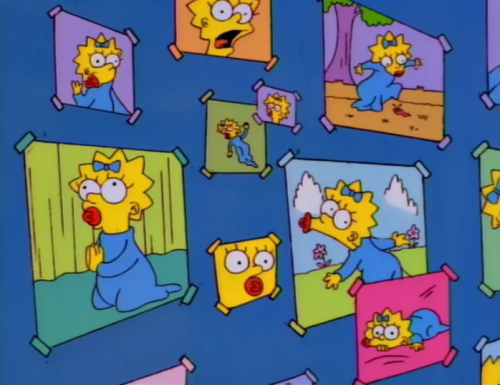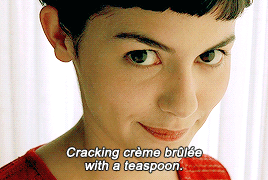Behind A TED-Ed Lesson: Animation + Inspiration
Behind a TED-Ed Lesson: Animation + Inspiration
To celebrate George Seurat’s birthday today, we thought we’d do a deep dive behind the scenes of one of our animated lessons, How do schools of fish swim in harmony?, which is about the concept of ‘emergence’ and whose animated style just so happens to have been largely influenced by the paintings of George Seurat and his contemporaries.

Emergence refers to the spontaneous creation of sophisticated behaviors and functions from large groups of simple elements, and can be used to explain the movements of ants, fish, and birds, as well as how the tiny cells in your brain give rise to the complex thoughts, memories, and consciousness that are you.

A Sunday Afternoon on the Island of La Grande Jatte, George Seurat (1884–86)
It’s kind of like a pointillist painting. When you zoom in real close, it’s just a collection of chaotic brush strokes. But take a few steps back, and you’ll see that all of those brush strokes are working together to illustrate a complex and detailed scene.

Pointillism stems from Impressionism, and depending on the artist’s technique, the size of the brush strokes vary, but are always visible. For example, Vincent van Gogh’s The Starry Night uses larger brush strokes in the night sky. Both the above and below concept designs show the animator of this lesson testing out how different brushstrokes interact to create depth within a scene. She decided that the swirling waters would make sense as large brushstrokes, which also offered contrast to allow the small fish to stand out.

George Seurat also employed a technique called ‘divisionism’, sometimes known as ‘chromoluminarism’, in which colors were separated into individual dots or patches which interacted optically. So, rather than relying on mixing colors, painters like Seurat and Paul Signac juxtaposed contrasting colors to allow for optical mixing - which in theory would produce more vibrant and pure colors than the traditional process of mixing pigments.

Circus Sideshow (Parade de Cirque), George Seurat (1887–88)
While designing this TED-Ed lesson, George Seurat and Paul Signac’s paintings provided inspiration not just for the brushstroke technique, but also for the color palette.

This GIF of the brain and it’s neural connections draws many of its colors from Seurat’s circus series palette, while the brighter colors - such as the ones used in the title GIF above - are drawn from the more vibrant colors commonly used by Paul Signac, like in the painting below.

Notre-Dame-de-la-Garde (La Bonne-Mère), Marseilles, Paul Signac (1905-06)

Animating this lesson was an opportunity to renew a sense of wonder in our ever complex universe, whether studying it up close or from afar. We hope that watching it might do the same for you!
From the TED-Ed Lesson How do schools of fish swim in harmony? - Nathan S. Jacobs
Animation by TED-Ed // Lisa LaBracio
More Posts from Smparticle2 and Others

(Image caption: New model mimics the connectivity of the brain by connecting three distinct brain regions on a chip. Credit: Disease Biophysics Group/Harvard University)
Multiregional brain on a chip
Harvard University researchers have developed a multiregional brain-on-a-chip that models the connectivity between three distinct regions of the brain. The in vitro model was used to extensively characterize the differences between neurons from different regions of the brain and to mimic the system’s connectivity.
The research was published in the Journal of Neurophysiology.
“The brain is so much more than individual neurons,” said Ben Maoz, co-first author of the paper and postdoctoral fellow in the Disease Biophysics Group in the Harvard John A. Paulson School of Engineering and Applied Sciences (SEAS). “It’s about the different types of cells and the connectivity between different regions of the brain. When modeling the brain, you need to be able to recapitulate that connectivity because there are many different diseases that attack those connections.”
“Roughly twenty-six percent of the US healthcare budget is spent on neurological and psychiatric disorders,” said Kit Parker, the Tarr Family Professor of Bioengineering and Applied Physics Building at SEAS and Core Faculty Member of the Wyss Institute for Biologically Inspired Engineering at Harvard University. “Tools to support the development of therapeutics to alleviate the suffering of these patients is not only the human thing to do, it is the best means of reducing this cost.“
Researchers from the Disease Biophysics Group at SEAS and the Wyss Institute modeled three regions of the brain most affected by schizophrenia — the amygdala, hippocampus and prefrontal cortex.
They began by characterizing the cell composition, protein expression, metabolism, and electrical activity of neurons from each region in vitro.
“It’s no surprise that neurons in distinct regions of the brain are different but it is surprising just how different they are,” said Stephanie Dauth, co-first author of the paper and former postdoctoral fellow in the Disease Biophysics Group. “We found that the cell-type ratio, the metabolism, the protein expression and the electrical activity all differ between regions in vitro. This shows that it does make a difference which brain region’s neurons you’re working with.”
Next, the team looked at how these neurons change when they’re communicating with one another. To do that, they cultured cells from each region independently and then let the cells establish connections via guided pathways embedded in the chip.
The researchers then measured cell composition and electrical activity again and found that the cells dramatically changed when they were in contact with neurons from different regions.
“When the cells are communicating with other regions, the cellular composition of the culture changes, the electrophysiology changes, all these inherent properties of the neurons change,” said Maoz. “This shows how important it is to implement different brain regions into in vitro models, especially when studying how neurological diseases impact connected regions of the brain.”
To demonstrate the chip’s efficacy in modeling disease, the team doped different regions of the brain with the drug Phencyclidine hydrochloride — commonly known as PCP — which simulates schizophrenia. The brain-on-a-chip allowed the researchers for the first time to look at both the drug’s impact on the individual regions as well as its downstream effect on the interconnected regions in vitro.
The brain-on-a-chip could be useful for studying any number of neurological and psychiatric diseases, including drug addiction, post traumatic stress disorder, and traumatic brain injury.
"To date, the Connectome project has not recognized all of the networks in the brain,” said Parker. “In our studies, we are showing that the extracellular matrix network is an important part of distinguishing different brain regions and that, subsequently, physiological and pathophysiological processes in these brain regions are unique. This advance will not only enable the development of therapeutics, but fundamental insights as to how we think, feel, and survive.”










» Medical Specialties «


You are the center of wonderland & Keep the last glow in mind by Jana Luo

Untitled // Jake Chamseddine
New ways to mass produce human neurons for studying neuropsychiatric disorders
Scientists from Singapore have streamlined the process of using human stem cells to mass produce GABAergic neurons (GNs) in the laboratory. This new protocol provides scientists with a robust source of GNs to study many psychiatric and neurological disorders such as autism, schizophrenia, and epilepsy, which are thought to develop at least in part due to GN dysfunction.
GNs are inhibitory neurons that reduce neuronal activation, and make up roughly 20 per cent of the human brain. They work alongside excitatory neurons (ENs) to ensure balanced neural activity for normal brain function. The coordinated interplay between GNs and ENs orchestrate specific activation patterns in the brain, which are responsible for our behaviour, emotions, and higher reasoning. Functional impairment of GNs results in imbalanced neural activity, thereby contributing to the symptoms observed in many psychiatric disorders.
The availability of high quality, functional human GN populations would facilitate the development of good models for studying psychiatric disorders, as well as for screening drug effects on specific populations of neurons. Scientists worldwide have been hard at work trying to generate a consistent supply of GNs in the laboratory, but have been faced with many challenges. Protocols involving multiple complex stages, poor yield, and requiring a long time to generate mature and functional GNs are just some of the limitations encountered.
Many of these limitations have now been overcome by the development of a rapid and robust protocol to generate GNs from human pluripotent stem cells (hPSCs) in a single step. With the addition of a specific combination of factors, hPSCs turn into mature and functional GNs in a mere six – eight weeks. This is about two – three times faster than the 10 - 30 weeks required for previous protocols. In addition, this new protocol is highly efficient, with GNs making up more than 80 per cent of the final neuron population.
To develop this protocol, the team from Duke-NUS Medical School (Duke-NUS), A*STAR’s Genome Institute of Singapore (GIS) and the National Neuroscience Institute (NNI) first identified genetic factors involved in GN development in the brain. The team then tried many different combinations of these factors, and succeeded in confirming that mature and functional human GNs were indeed generated.
“Just like how a balance of Yin and Yang is needed in order to stay healthy, a balance of ENs and GNs is required for normal brain function. We now know a fair bit about ENs because we have good protocols to make them. However, we still know very little of the other player, the GNs, because current protocols do not work well. Yet, when these GNs malfunction our brain goes haywire,” commented Dr Alfred Sun, a Research Fellow at NNI and co-first author of the publication alongside Mr Qiang Yuan, an NUS Graduate School PhD student.
“Our quick, efficient and easy way to mass produce GNs for lab use is a game changer for neuroscience and drug discovery. With increased recognition of the essential role of GNs in almost all neurological and psychiatric diseases, we envisage our new method to be widely used to advance research and drug screening,” said Dr Shawn Je, Assistant Professor in the Neuroscience and Behavioural Disorders Programme at Duke-NUS, and senior author of the study.
The speed and efficiency of generating GNs with this new protocol provides researchers unprecedented access to the quantities of neurons necessary for studying the role of GNs in disease mechanisms. Drugs and small molecules may now be screened at an unparalleled rate to discover the next blockbuster treatment for autism, schizophrenia, and epilepsy.






There is a time when it is necessary to abandon the used clothes, which already have the shape of our body and to forget our paths, which takes us always to the same places. This is the time to cross the river: and if we don’t dare to do it, we will have stayed, forever beneath ourselves
Fernando Pessoa (via paizleyrayz)


How we determine who’s to blame
How do people assign a cause to events they witness? Some philosophers have suggested that people determine responsibility for a particular outcome by imagining what would have happened if a suspected cause had not intervened.
This kind of reasoning, known as counterfactual simulation, is believed to occur in many situations. For example, soccer referees deciding whether a player should be credited with an “own goal” — a goal accidentally scored for the opposing team — must try to determine what would have happened had the player not touched the ball.
This process can be conscious, as in the soccer example, or unconscious, so that we are not even aware we are doing it. Using technology that tracks eye movements, cognitive scientists at MIT have now obtained the first direct evidence that people unconsciously use counterfactual simulation to imagine how a situation could have played out differently.
“This is the first time that we or anybody have been able to see those simulations happening online, to count how many a person is making, and show the correlation between those simulations and their judgments,” says Josh Tenenbaum, a professor in MIT’s Department of Brain and Cognitive Sciences, a member of MIT’s Computer Science and Artificial Intelligence Laboratory, and the senior author of the new study.
Tobias Gerstenberg, a postdoc at MIT who will be joining Stanford’s Psychology Department as an assistant professor next year, is the lead author of the paper, which appears in the Oct. 17 issue of Psychological Science. Other authors of the paper are MIT postdoc Matthew Peterson, Stanford University Associate Professor Noah Goodman, and University College London Professor David Lagnado.
Follow the ball
Until now, studies of counterfactual simulation could only use reports from people describing how they made judgments about responsibility, which offered only indirect evidence of how their minds were working.
Gerstenberg, Tenenbaum, and their colleagues set out to find more direct evidence by tracking people’s eye movements as they watched two billiard balls collide. The researchers created 18 videos showing different possible outcomes of the collisions. In some cases, the collision knocked one of the balls through a gate; in others, it prevented the ball from doing so.
Before watching the videos, some participants were told that they would be asked to rate how strongly they agreed with statements related to ball A’s effect on ball B, such as, “Ball A caused ball B to go through the gate.” Other participants were asked simply what the outcome of the collision was.
As the subjects watched the videos, the researchers were able to track their eye movements using an infrared light that reflects off the pupil and reveals where the eye is looking. This allowed the researchers, for the first time, to gain a window into how the mind imagines possible outcomes that did not occur.
“What’s really cool about eye tracking is it lets you see things that you’re not consciously aware of,” Tenenbaum says. “When psychologists and philosophers have proposed the idea of counterfactual simulation, they haven’t necessarily meant that you do this consciously. It’s something going on behind the surface, and eye tracking is able to reveal that.”
The researchers found that when participants were asked questions about ball A’s effect on the path of ball B, their eyes followed the course that ball B would have taken had ball A not interfered. Furthermore, the more uncertainty there was as to whether ball A had an effect on the outcome, the more often participants looked toward ball B’s imaginary trajectory.
“It’s in the close cases where you see the most counterfactual looks. They’re using those looks to resolve the uncertainty,” Tenenbaum says.
Participants who were asked only what the actual outcome had been did not perform the same eye movements along ball B’s alternative pathway.
“The idea that causality is based on counterfactual thinking is an idea that has been around for a long time, but direct evidence is largely lacking,” says Phillip Wolff, an associate professor of psychology at Emory University, who was not involved in the research. “This study offers more direct evidence for that view.”

(Image caption: In this video, two participants’ eye-movements are tracked while they watch a video clip. The blue dot indicates where each participant is looking on the screen. The participant on the left was asked to judge whether they thought that ball B went through the middle of the gate. Participants asked this question mostly looked at the balls and tried to predict where ball B would go. The participant on the right was asked to judge whether ball A caused ball B to go through the gate. Participants asked this question tried to simulate where ball B would have gone if ball A hadn’t been present in the scene. Credit: Tobias Gerstenberg)
How people think
The researchers are now using this approach to study more complex situations in which people use counterfactual simulation to make judgments of causality.
“We think this process of counterfactual simulation is really pervasive,” Gerstenberg says. “In many cases it may not be supported by eye movements, because there are many kinds of abstract counterfactual thinking that we just do in our mind. But the billiard-ball collisions lead to a particular kind of counterfactual simulation where we can see it.”
One example the researchers are studying is the following: Imagine ball C is headed for the gate, while balls A and B each head toward C. Either one could knock C off course, but A gets there first. Is B off the hook, or should it still bear some responsibility for the outcome?
“Part of what we are trying to do with this work is get a little bit more clarity on how people deal with these complex cases. In an ideal world, the work we’re doing can inform the notions of causality that are used in the law,” Gerstenberg says. “There is quite a bit of interaction between computer science, psychology, and legal science. We’re all in the same game of trying to understand how people think about causation.”






Amélie doesn’t have a boyfriend. She tried once or twice, but the results were a let-down. Instead, she cultivates a taste for small pleasures.
-
 dogananas liked this · 4 years ago
dogananas liked this · 4 years ago -
 irtayag reblogged this · 4 years ago
irtayag reblogged this · 4 years ago -
 what-about-impressionism reblogged this · 5 years ago
what-about-impressionism reblogged this · 5 years ago -
 pastel-with-nata liked this · 5 years ago
pastel-with-nata liked this · 5 years ago -
 tsubami612 reblogged this · 5 years ago
tsubami612 reblogged this · 5 years ago -
 tsubami612 liked this · 5 years ago
tsubami612 liked this · 5 years ago -
 no-feels-world reblogged this · 6 years ago
no-feels-world reblogged this · 6 years ago -
 no-feels-world liked this · 6 years ago
no-feels-world liked this · 6 years ago -
 shmoonani-blog liked this · 6 years ago
shmoonani-blog liked this · 6 years ago -
 kidakyle liked this · 6 years ago
kidakyle liked this · 6 years ago -
 1amees liked this · 6 years ago
1amees liked this · 6 years ago -
 geekotakuzion liked this · 6 years ago
geekotakuzion liked this · 6 years ago -
 gothamcitypoprocks liked this · 6 years ago
gothamcitypoprocks liked this · 6 years ago -
 tumbleweed-chaser liked this · 6 years ago
tumbleweed-chaser liked this · 6 years ago -
 creolecoutureboutique liked this · 6 years ago
creolecoutureboutique liked this · 6 years ago -
 noodle-of-sunshine liked this · 6 years ago
noodle-of-sunshine liked this · 6 years ago -
 lutefisk-kingdom liked this · 6 years ago
lutefisk-kingdom liked this · 6 years ago -
 dima-blue liked this · 6 years ago
dima-blue liked this · 6 years ago -
 sedikitruang liked this · 6 years ago
sedikitruang liked this · 6 years ago -
 princessbydawnbr liked this · 6 years ago
princessbydawnbr liked this · 6 years ago -
 mifit5 liked this · 6 years ago
mifit5 liked this · 6 years ago -
 jdjohnsno liked this · 6 years ago
jdjohnsno liked this · 6 years ago -
 mkelley1961 liked this · 6 years ago
mkelley1961 liked this · 6 years ago -
 rogerioreal liked this · 6 years ago
rogerioreal liked this · 6 years ago -
 simone2341 liked this · 6 years ago
simone2341 liked this · 6 years ago -
 macv9697 liked this · 6 years ago
macv9697 liked this · 6 years ago -
 spyfox2017-blog liked this · 6 years ago
spyfox2017-blog liked this · 6 years ago -
 lmknjbhvgc liked this · 6 years ago
lmknjbhvgc liked this · 6 years ago -
 itshoare-lipene liked this · 6 years ago
itshoare-lipene liked this · 6 years ago -
 itshoare-lipene reblogged this · 6 years ago
itshoare-lipene reblogged this · 6 years ago -
 mallacreblog reblogged this · 6 years ago
mallacreblog reblogged this · 6 years ago -
 thatsgoodi liked this · 6 years ago
thatsgoodi liked this · 6 years ago -
 trouble5478 liked this · 6 years ago
trouble5478 liked this · 6 years ago -
 toma202 liked this · 6 years ago
toma202 liked this · 6 years ago -
 kitkat-kate-kathy liked this · 6 years ago
kitkat-kate-kathy liked this · 6 years ago -
 thom-westmond liked this · 6 years ago
thom-westmond liked this · 6 years ago -
 jwacademy reblogged this · 6 years ago
jwacademy reblogged this · 6 years ago -
 johndovey reblogged this · 6 years ago
johndovey reblogged this · 6 years ago -
 johndovey liked this · 6 years ago
johndovey liked this · 6 years ago -
 evelynedubois liked this · 6 years ago
evelynedubois liked this · 6 years ago -
 streetpiracy liked this · 6 years ago
streetpiracy liked this · 6 years ago -
 farawaylongago liked this · 6 years ago
farawaylongago liked this · 6 years ago -
 etceterodactyl liked this · 6 years ago
etceterodactyl liked this · 6 years ago -
 sheepteeth reblogged this · 6 years ago
sheepteeth reblogged this · 6 years ago -
 sheepteeth liked this · 6 years ago
sheepteeth liked this · 6 years ago